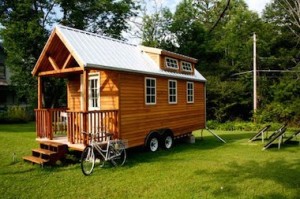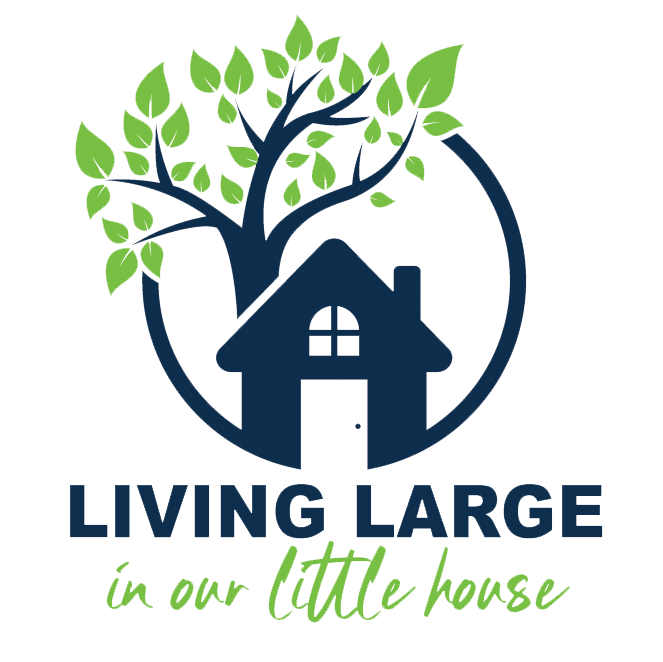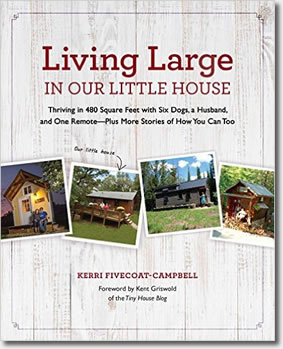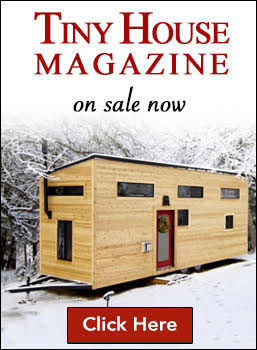There is Reason to Report on the Small House Movement, or My Math is Better Than Your Math
Ah, here I am again, blogging about the tiny/small house movement in an effort to try to explain it to someone who obviously will never get it.
I ran across an article yesterday on Housing Wire, intelligently entitled, “Nope, Tiny Houses are not the Next Big Thing: Sorry man – size matters.”
In the article, author Trey Garrison lambasts journalists for not being good with numbers. He goes on with his argument that the media coverage on the tiny/small house movement is unwarranted because the statistics show that homes are, in fact, getting bigger.
He then goes on by taking barbs at tiny house dwellers as “a few hipsters and other assorted folks who make bad decisions.”
On that point about square footage, he is correct. New home construction is increasing in size and in fact, has hit a record at an average of 2,607 square feet, and yes, with the exception of a couple of years during the recession, has grown from 1,500 square feet since 1970.
What Garrison fails to also cover in his in-depth analysis of tiny house dwellers is that while new home square footage is growing, home ownership in the U.S. is on the decline.
According to an article in Bloomberg earlier this year, home ownership in the U.S. is at its lowest in 19 years at 64.8 percent. This is down from a high in 2004 of 69.2 percent. “Recovering home prices and mortgage rates that have climbed from near-record lows last May have put real estate out of reach for some would-be buyers,” the article explains.
So, who is buying all of these brand new McMansions? Not the shrinking middle class in America and it certainly isn’t the poor, which, as a group, is growing larger. “The idea that the median American has so much more income than the middle class in all other parts of the world is not true these days,” Lawrence Katz, a Harvard economist told the New York Times. “In 1960, we were massively richer than anyone else. In 1980, we were richer. In the 1990s, we were still richer.” That is no longer the case, Professor Katz added.
One of the biggest benefits of the tiny/small house movement is that of lower construction costs and for many, debt free living. Of course, there are other reasons aside from economic ones that Americans and people all over the world are looking toward tiny/small house living. Those reasons include concerns for sustainability/the environmental footprint, mobility for homes that are on trailers and freedom to actually live our passions free of the high maintenance of a large home.
Garrison also fails to acknowledge that most tiny/small homes are DIY builds. Therefore, they do not show up on Home Builder Association surveys, and will never be included in average square footage tallies. And because many are built debt free, they also don’t show up on mortgage lenders radars.
But maybe that is exactly what Garrison and his publication has against the tiny/small house movement. The publication is described on its’ website as “by far the nation’s most influential source of news and information for U.S. mortgage markets.” As with cities that aren’t collecting taxes and utility companies that aren’t able to charge many tiny/small homeowners huge fees, this publication might actually be afraid that the tiny/small house movement is more than the “flash-in-the-pan fad of glorified trailers with fancy trim,” it describes.
Homeowners who don’t need mortgages means less advertising revenue for publications that depend on the mortgage industry.
Yes, the tiny/small house movement is little right now, but there is no denying its growing. Will it ever dominate the housing market? I doubt it. It’s not for everyone, but for people who have found happiness and freedom in it, they don’t deserve to be called “hipsters and assorted folks who make bad decisions.”
For the record, I know we do not fall into Garrison’s definition of a tiny house (according to him, under 400 square feet and on wheels). I’m a journalist, but I can count, I even have a degree in business. We are at 480-square feet and on a permanent foundation. Still, I take offense to his characterization that people like us are “making bad decisions” (for who? Your beloved mortgage industry?).
Here’s how I see our future in our small home once all of our goals are realized:
-0- Debt
+
-0- Days worrying about high maintenance, utility bills, high tax bills and our footprint on the environment
+ -0- Days being a slave to corporate employers who only see employees as a line item on a balance sheet
=365 days of happily living our passions and truly Living Large
How’s that math for ya?









Today is my first day to join your group. I live in an 1800 sq ft home, but this coming Monday I have hired a handyman builder to double the size of my storage house/workshop in my backyard. It backs up to woods. Although I’m in a neighborhood there is much privacy in my yard, so I don’t anticipate any nosy neighbors complaining. The shop currently has electricity, but additional wiring is needed. The sq footage will be between 400-500. You’re probably wondering why I’m doing this. My stepdaughter is 45 and doesn’t have a job that pays well enough for her to continue paying $700 rent on a dumpy small apartment. So instead of helping her throw her money away….I think that the tiny house is a great idea. She doesn’t seem to be on board yet, but once the construction begins, I feel like she’ll get excited. My budget is $12,000 (that’s the amount that I can borrow using my car title) With such a small budget, I’ll be doing some of the work myself. I plan on documenting the progress from day one. Wish me luck!!
Good luck, Nan and welcome to our Living Large community!
Nice post. Although I would like to add, as a homebuilder myself, that while building small/tiny does reduce the overall cost it increases the cost per square foot. I see this quite often where people expect a 500sf house to be 1/4 the price of a comparably built 2000sf home. I’m still a fan of the movement I just wish more people would understand the economics of scale involved.
I do think a lot of people understand the economies of scale, Bryan. But it also doesn’t have to increase the cost per square foot. Small homes are easier to build with reclaimed materials, for example, which would greatly reduce the cost per square foot.
I am 60 and currently live in a 1400 Square foot home. It has 3 bedrooms and 1 bathroom and a dining room plus kitchen with breakfast area and a laundry room. I use the living room which is open to the dining room, my bedroom, the kitchen cooking area only and the bathroom. The rest is just unused space. That I am paying for. I am confident that I could put a kitchen and bathroom and a living area plus a bed. Which I would be quite happy with a hide away sofa bed, in just my living and dining room area that is less than 400 square feet. But I hope with a little ingenuity to do it in 250 square feet or less. I have all this stuff that I have accumulated over the years…little collectibles all kinds of decor but its just for decorations that not a lot of people even see… I have a very small family and I don’t entertain much. I have already started downsizing even though I haven’t even started a Tiny House. Since I am on a fixed income I have to come up with a way to finance it…..but I plan to do that one way or another. I want mine to be stationary, with a small covered porch to hold a couple of chairs. And a washer/dryer combo. And it can be almost anywhere in the continental U.S. as I’m free as a bird and ready for change. Although I would really love the Portland or Seattle area. I love the rain. So I ask all my fellow Tiny House lovers to say a prayer for me. Thanks for listening.
Keep working to reduce that clutter, Shirley and working on ways to get into your tiny dream. We’re rooting for you!
Shirley
You could start and sell your collectibles, which would start your fund 🙂
In the meantime, could you let out your spare bedroom? Another source of income.
Good luck in fulfilling your dreams 🙂
Excellent suggestions!
Good Luck Shirley! You can make money by selling your “stuff” on ebay, Etsy or Craigslist. My hubby and I live in a 1100 sf home, with a detached garage, nice patio and yard. I know that you will love Small house living. The more room you have the more stuff you collect!
Mr. “Lambast” may have issues with individuals and families who have a reachable goal, happy, self-reliant and resourceful: a community world-wide of like-minded people of varied cultures. Tiny Houses rule.
Sometimes people who are stressed or jealous or wish they could do the same find it satisfactory to berate those they can not touch. What with the economy and shrinking money markets he might be tightening the notches on his belt as well. He should try it, he might like it. If not, no harm done.
There is nothing wrong with making money and lots of it but best done without belittling the dream of others who can fulfill their goals for a lot less square foot and peace-of-mind.
😀
You tell ’em Brin! I don’t have anything against money. As Adam Sandler’s character, Robbie, says in the movie The Wedding Singer, “I’m a big fan of money. I like it. I use it. I have a little. It’s in a jar on top of my refrigerator. I’d like to put more in that jar.” Life is easier with some, for sure, it even helps us help others. But it isn’t what truly makes us happy.
To Kerri, well, he’s writing about something he has not researched and he certainly doesn’t speak for me or the rest of us…and if he wants to throw insults…he’d better take a step back. I stand my ground for what I believe in. 🙂
Thumbs up!
Just a quick thought (or two):
I’m currently one of the long term unemployed. But I am educated (BS in BUsiness Management) and was a Director of IT for 15+ years.
I can tell you that businesses do not look at employees as a line item on a balance sheet. Today, with such poor leadership, employees are not viewed as assets. Businesses today view employees and related costs as expenses. Payroll. Healthcare. 401Ks. All expense, all P&L items.
Smart leaders used to view employees as “Human Capital” and as assets. But that is a thing of the past.
I dream of one day being a Tiny Home dweller for all the reasons you espouse. THe thing is, as Tiny Home ownership grows, so too will the inevitable creative taxation that, while at present has not occurred, will make its way onto the Tiny Home Industry. Big Builders will lobby for taxation, permits, you name it, and that advantage (tax free) will disappear. I hope I’m wrong, but I doubt it.
But in the end, you are right: With Inequality rising, the only ones affording McMansions are the wealthy elite, the one percenters. That’s where all the growth has been.
My wife, sick with MS, will never give up her 1600 sq foot home. For me, I’d give it up in a heart beat. The taxes (NY) are insane, the costs on my VA mortgage are the largest portion of our monthly expenses. People pay too much for homes they don’t need that are too big in order to fill them with too much stuff they don’t need.
One day, perhaps, the Tiny Home Movement may make a real dent in living choices and home building demographics. For today, it’s a niche, and that’s good for you all. YOu get all the advantages without the (as yet) government meddling and taxation.
I say good for you! Bravo!
I completely agree with you, Robert, I should have made that clearer, that employees are a negative line item on a balance sheet, even if they are bringing in money and helping the company grow. Thanks for your comments. I’m sorry you are part of the long term unemployed. I hope that things turn around for you soon.
We live in a 1641 sq ft house, built in 2007, the 2nd smallest model available in our neighborhood. We were able to afford it based on my husband’s overtime which went away while the house was being built. The mortgage industry did us no favor by over qualifying us for this loan.
By the time our house was built the housing bubble had burst and we were stuck with a house we couldn’t afford and couldn’t dump.
We almost lost it but were able to get a loan modification after jumping through hoops for over a year.
The modification extended our mortgage to a 40 year loan with a $59,000 balloon due at the end or when we sell. We will be 90 when this place is paid off.
I would love to walk away and live in a tiny or small house.
I do agree that bigger is better, it’s just a matter of what I want to be bigger. I want to be able to visit friends and relatives in other states. I want to be free to give to orphanages and dig wells for people in need. Following my dreams is the bigger that I want to pursue, not being a slave to a house and job that I can never get out from under.
I want a small house on acreage with its own water source. I want to build a pavillion with an outdoor kitchen that would accommodate the occasional large family gatherings, a place where we can be awed by God’s creation rather than someone’s monument to self.
We were in kind of the same fix, Melissa. A week or so after we signed the contract and for a 6 year construction loan on The Belle Writer’s Studio, my husband was laid off. We barely hung on for those 18 months and had already made an appointment with a realtor for the next day when my husband was called back. It wasn’t a 40 year loan, but when your income has been chopped to next to nothing, it doesn’t matter how long the loan is, they want their money (as we both know). Thankfully, our lives turned around just in time to stay here. Your dream sounds lovely, we’ll be cheering you on to get there!
Thank you Kerri. Your story and beautiful home are an inspiration to those of us still in the dream phase.
Thanks, Melissa. I’m so happy it does!
Describe the tiny house lifestyle in three words
1. Debt free
2. Emotionally peaceful
3. Financial security
4. Minimalistic
5. Mortage free
LOL, David. Good one. I see construction managers don’t have a grip on math, either. 🙂